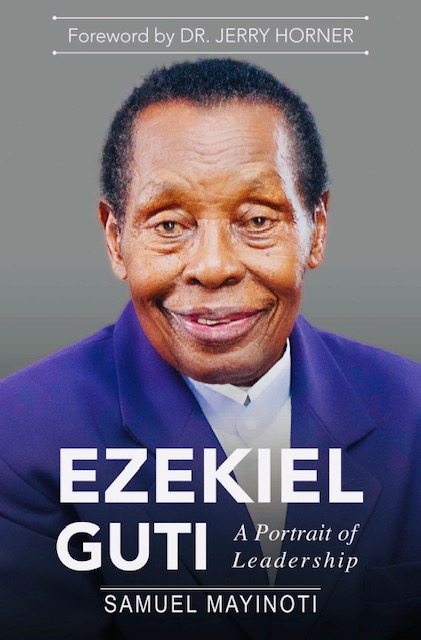
- Title: Ezekiel Guti, A Portrait of Leadership
- Author: Samuel Mayinoti
- Publisher: Africa Blossom, Windhoek (2021)
- Length: 293 pages preceded by xviii pages;
- Special features: Abbreviations & acronyms; Glossary of Selected Terms; Select Bibliography; Index.
Ezekiel Guti, A Portrait of Leadership, written by Samuel Mayinoti, a Namibia-based Zimbabwean national, sheds rare light onto the leadership style, experiences and accomplishments of Ezekiel Guti, the founder of ZAOGA Forward in Faith church.
The foreword was written by Jerry Horner, a former theology Professor at Oral Roberts University in Tulsa, USA. Ezekiel Guti is a well-known public figure in Zimbabwe whose personality and church have attracted mixed media coverage.
In this recently published book, Mayinoti starts off with a preface in which he shares his reasons for deciding to write about Ezekiel Guti’s leadership. He points out that Ezekiel Guti is an under documented world influencer.
Although Mayinoti suggests that he is not the most qualified to write about Ezekiel Guti because he has never had close association with the man, he goes on to state that he writes from a vantage point of 33 years of being under the ministry of Ezekiel Guti.
The book blends reflections and recollections of interviewees who have associated with Ezekiel Guti from as early as 1960. Notable figures cited include Mensa Otabil, Myles Munroe, Freda Lindsay, Tom Deuschle among others. Mayinoti occasionally blends his own recollections and views as a “participant observer.”
Written in the fashion of literary nonfiction, the book highlights stories and testimonies that illustrate Ezekiel Guti’s leadership. Utilising epigraphs, vignettes and a sprinkling of metaphors among other literary devices, it is clear that the author intended the book to be exciting and engaging while at the same presenting facts pertaining to Ezekiel Guti’s life and leadership. Ninteen of the 20 chapters end with reference notes to support claims in the main text.
In the first chapter, Mayinoti describes Ezekiel Guti’s accomplishments that include: Having churches in more than 130 countries and 22 States, founding a university, hospital and 10 schools as well as overseeing close to 5,000 full time pastors and “millions of congregants.”
The author further claims that Guti’s accomplishments “would take several lifetimes for the average person to attain.” He then points out, by citing some interviewees, that Ezekiel Guti is somewhat of an enigma if one looks at him vis-à-vis his transnational influence and achievements.
- Chamisa under fire over US$120K donation
- Mavhunga puts DeMbare into Chibuku quarterfinals
- Pension funds bet on Cabora Bassa oilfields
- Councils defy govt fire tender directive
Keep Reading
From the second chapter onwards, Mayinoti presents accounts and stories that highlight Ezekiel Guti’s key leadership traits that include vision, strategy, people skills, resilience, teaching, training, administration, change management and integrity. There is also a chapter that sheds light onto how Guti has handled “success”, including his attitude when criticized.
Another chapter gives an overview of Guti’s preaching, writing and notable quotes. In chapter 18 of the book Mayinoti argues that Guti’s leadership cannot be explained through natural frameworks alone, and describes him as a spiritual man whose source and power of leadership is divine.
October 28th, the 19th and penultimate chapter, summarises the author’s meeting with Ezekiel Guti. Here, the reader is presented with Guti’s own views and reflections around a number of issues such as persecution, changing times, leadership character and divine providence. The writer highlights Guti’s massive memory of events, people and places.
In the last chapter dubbed The Leader, the Legacy, the writer sums up his own views about Guti’s leadership personality and legacy. Guti is presented as a major protagonist in the worldwide Pentecostal revival spanning the 20th and 21st centuries.
Mayinoti hints to Guti’s succession plan and management in a rather hushed tone, only mentioning that since many years ago, Guti has been ‘deliberately leading a process of passing on leadership to the young generation” in his church.
The book is doubtlessly a great contribution to the literature of religion and specifically church leadership in Zimbabwe and Africa. Mayinoti did not conceal the fact that he wrote as a follower and insider.
The language, especially a tendency to constantly refer to Guti as “Apostle” can justify describing the author as an apologist and the book as hagiographic. Readers are left, as the preface puts it, to react by “initiating and amplifying conversations, and perhaps challenge others to write alternative narratives.”
Based on the writing style, evidence presented and themes covered to illuminate Guti’s leadership, Mayinoti has written a compelling narrative that makes Guti stand out from the ever-growing pack of people claiming the title of “Man of God”.
Guti’s leadership style as presented in the book can find application even in secular contexts. The book is arguably in its own class as well argued account about a leader by a follower. It will likely elicit mixed reviews and reactions from a wide range of readers.











